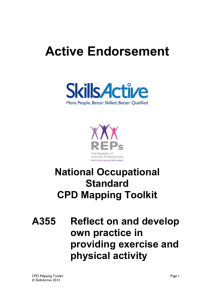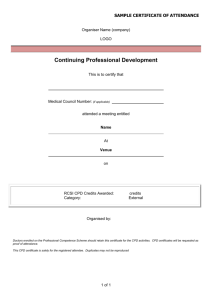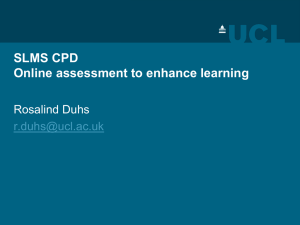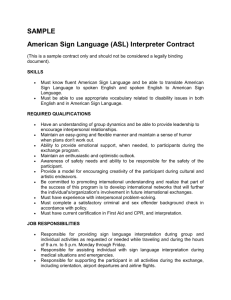D522 - SkillsActive
advertisement
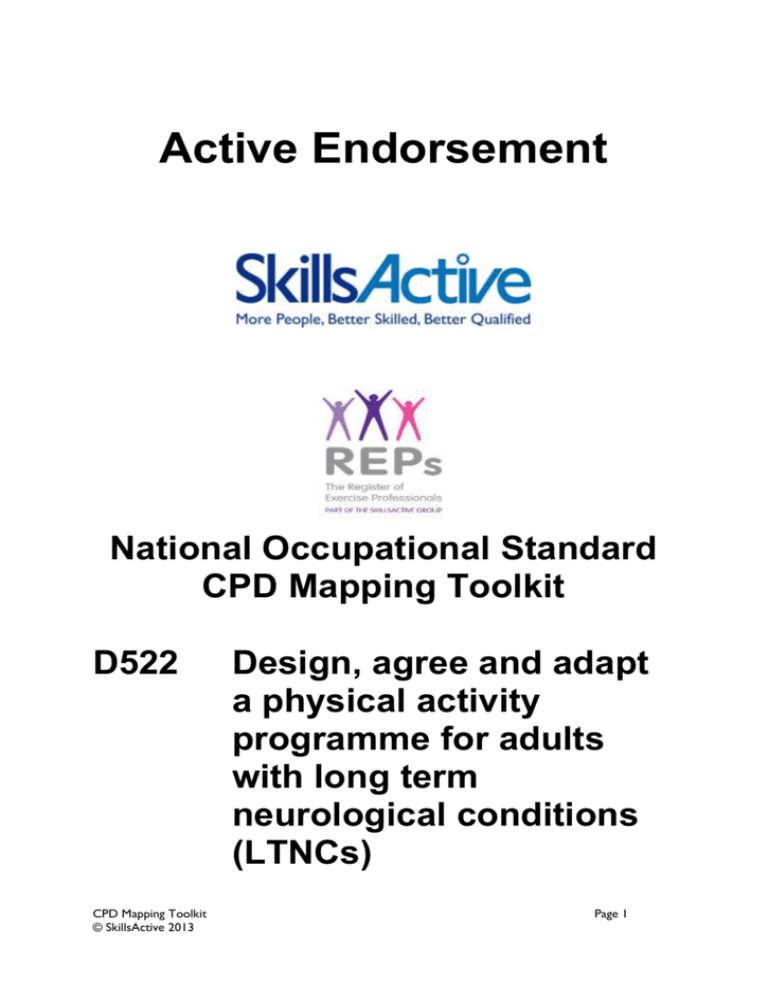
Active Endorsement National Occupational Standard CPD Mapping Toolkit D522 CPD Mapping Toolkit © SkillsActive 2013 Design, agree and adapt a physical activity programme for adults with long term neurological conditions (LTNCs) Page 1 Mapping CPD Courses to National Occupational Standards (NOS) NOS or ‘standards’ establish the benchmark of competence required in different fitness industry roles/skills. Each NOS consists of a detailed breakdown of the minimum skills and knowledge needed to be competent. Developed in conjunction with technical experts and employers, NOS act to ensure employability skills are reflected in qualifications and CPD. Training providers are required to part-map CPD courses to demonstrate occupational relevance (e.g. to the learner and employer). N.B. There is no requirement to fully-map CPD to the NOS. How to Complete this Mapping Toolkit 1. Review the content of your course (including learning outcomes and assessment criteria) in relation to the NOS contained within this mapping toolkit. 2. Demonstrate how and where your CPD course covers the NOS by completing the relevant sections within the ‘Mapping Evidence’ column throughout this mapping toolkit. 3. Mapping need only be completed for elements of the NOS where there is a clear link to content and/or assessment covered by the CPD course. All areas that are not covered by the CPD should be left blank or denoted as not applicable (N/A). You will not be penalised for leaving mapping blank where it is irrelevant to your course. 4. The information you add to the ‘Mapping Evidence’ column can include any aspect of course delivery/resources/assessment etc such as, PowerPoint presentations, course manuals, handouts, assessments, lesson plans. It is, however, important that you are able to submit anything you have mapped as evidence for the endorsement process. CPD Mapping Toolkit © SkillsActive 2013 Page 2 D522 Design, agree and adapt a physical activity programme for adults with long term neurological conditions (LTNCs) Summary Patients with long-term neurological conditions (LTNCs) are at present poorly served with regard to exercise referral, despite a growing evidence base confirming the value of exercise for this patient group. Hospital and GP referral of individuals with LTNCs to tailored exercise programs is at present limited, though the benefits to be accrued are being increasingly realised by both individual health practitioners and societies such as the MS Society and the Parkinson’s Disease Association. Delivery of such services should follow guidelines which provide guidance on participant inclusion /exclusion criteria and competency of instructors, to ensure safe effective practice and protect the interests of participants and instructors. Practitioners and other healthcare professionals may specifically direct a patient to suitably trained instructors and facilities where a structured and individualised physical activity programme can be designed and delivered for them, including home exercise. Fitness instructors who are responsible for designing and delivering structured and individualised physical activity programmes for participants with a LTNC or assigning them to an appropriate physical activity must have a range of appropriate knowledge and skills specific to current guidelines and monitoring the effects of the programme on their conditions. These instructors should have established close liaison with neurology health professionals in their local area. Tailoring an exercise programme will use many of the core aspects of programme design and delivery such as communication skills, principles of training and guidelines for teaching. In addition, there are specific knowledge and skills related to working practice and the technical exercise aspects to consider in programme design including: understanding of the particular disease process and how it is managed; how physical activity influences the disease process; the positive and negative aspects of physical activity on neurological disease; an understanding of relevant medications and their influence on the individual's ability to exercise, and also psycho-social issues. The latter are particularly important to LTNC patients in terms of perceived barriers to exercise participation, such as transport and the lack of appropriately skilled instructors, which deter many of them from embarking on exercise programs This unit is designed to cover LTNCs, except for stroke which is covered in a separate unit, and includes the skills and knowledge required to prescribe safe and effective exercise programmes for this patient group. Elements covered: D522.1 Design and agree a physical activity programme for participants with LTNCs D522.2 Deliver, review and adapt a physical activity programme for participants with LTNCs CPD Mapping Toolkit © SkillsActive 2013 Page 3 D522.1 Design and agree a physical activity programme for participants with LTNCs Competencies/Skills 1 establish an effective working relationship with participants, their carers and appropriate health care professionals 2 collect, record and interpret information about your participant with neurological disease using safe, appropriate and recognised methods, ensuring to liaise with health care professionals regarding the interpretation of information, as required Mapping Evidence Information to cover: a) personal goals b) referral form c) informed consent to participate to transfer medical information d) medical history and medication e) current and previous physical activity history and preferences f) functional capacity and risk assessment g) social and psychological considerations h) outcome measurement Methods to cover: a) reports b) interview c) questionnaire d) observation e) functional assessments f) risk assessment 3 stratify and manage risk according to appropriate guidelines and protocols 4 follow the correct procedures and protocols for liaising with health care professionals, including those for confidentiality 5 establish and agree the participant’s readiness to participate 6 plan and agree goals that are appropriate to your client and their current level of ability 7 plan and prepare objectives, activities and delivery methods (see 1 above) that are appropriate to your participant’s goals and condition 8 design and agree a programme adapted to your participant’s needs CPD Mapping Toolkit © SkillsActive 2013 Page 4 D522.2 Deliver, review and adapt a physical activity programme for participants with LTNCs Competencies/Skills 1 assess, monitor and manage risk to your participant throughout the programme 2 Manage medical complications and emergencies within the boundaries of your role until the required medical help is available 3 deliver planned activities to your participant, adapting and tailoring activities according to their individual needs 4 communicate and consult with your participant on issues to do with their physical activity programme and progress 5 provide appropriate attention to your participant’s with common co-morbidities 6 support participant’s in ways which will promote sustained change in physical activity levels 7 enable your participant to move towards self-management, selfmotivation and participation through appropriate educational opportunities 8 monitor your participant’s progress against agreed goals and outcome measures, and adapt the programme accordingly 9 provide ongoing reports to communicate outcomes to the appropriate health care/other professionals D522 Mapping Evidence Design, agree and adapt a physical activity programme for adults with long term neurological conditions (LTNCs) Knowledge and Understanding Mapping Evidence K1 Government policy and published national guidelines for LTNC rehabilitation. K2 Awareness of national agencies, organisations and literature relating to LTNCs. K3 Relevant medico-legal requirements. K4 How to interact appropriately with general practitioners, other health care professionals and personnel involved in the process of neurological rehabilitation. K5 The importance of ensuring the participant’s information and consent, meeting recommended guidelines, is received prior to advising, prescribing or instructing exercise. CPD Mapping Toolkit © SkillsActive 2013 Page 5 K6 The protocol to follow when dealing with participants who have been referred from primary care or hospital. K7 The importance of an agreed link with a named specialist from the hospital and/or community neurological team. K8 Barriers to communication with the referred participant and the communication skills needed to overcome these. K9 How to identify when the participant needs to consult health care professionals. K10 How to identify changes in condition that indicate the patient should be referred back to the referring health care professional. K11 Ethical considerations involved in on-going maintenance of exercise behaviour including respecting inter-professional boundaries and participant confidentiality. K12 Methods of information collection and interpretation, appropriate storage of confidential records and management processes encountered in running exercise programs. K13 Current relevant structures of the National Health Service, the names and functions of different relevant medical organisations and service providers. K14 Background and evidence base to neurological exercise prescription. K15 Common risk factors and co-morbidities in neurological medicine. K16 How physical activity may influence other risk factors. K17 Anatomy and physiology of the nervous system. K18 Prevalence, causes, presentation, diagnosis, treatment, course and prognosis of the following: a. Multiple sclerosis b. Parkinson’s Disease c. Cerebral palsy d. Neuromuscular conditions e. Motor neurone disease f. Acquired brain injury g. Spinal Cord Injury K19 Investigations for neurological disease including: a. Neurological examination b. Physiological investigations c. CT /MRI imaging K20 Co-morbidity considerations such as: a. Heart disease b. Hyperlipidaemia c. Hypertension d. Diabetes e. Depression and anxiety f. Arthritis CPD Mapping Toolkit © SkillsActive 2013 Page 6 K21 The range of neurological medications and their exercise considerations. K22 Individual risk stratification using recognised guidelines and protocols. K23 Acute responses and chronic adaptations to endurance and strength training and implications for the individual with neurological disease. K24 Beneficial effects of physical activity on neurological conditions. K25 Contra-indications to exercise which need to be taken into account for neurological diseases. K26 Initial assessment including appropriate assessment of exercise level using recognised sub-maximal tests. K27 The on-going screening process prior to each exercise session. K28 How to set up and manage a safe physical activity environment relevant for neurological diseases. K29 Both group and individual exercise programming principles for the participant with neurological disease following guidelines. K30 Monitoring intensity methods, e.g. heart rate and perceived exertion. K31 Exercise considerations for the participant with: a. Multiple sclerosis e.g. temperature regulation b. Parkinson’s Disease e.g. timing of exercise and medication c. Cerebral palsy e.g. management of contractures d. Neuromuscular conditions e.g. care in content of strengthening program e. Motor neurone disease e.g. consideration of disease progression f. Acquired brain injury e.g. behavioural issues g. Spinal Cord Injury e.g. sensory and autonomic considerations K32 How to manage fluid, dietary and sanitary needs in and around the exercise session. K33 How to determine and adapt appropriate progressive physical activity programmes appropriate to the condition using results from the physical/exercise assessments, medical information, national guidelines, consultation and participant aims. K34 The motivational processes, models and techniques involved in behavioural change for the referred patient/client to encourage beneficial lifestyle changes and providing appropriate support to sustain such changes. K35 Mental health and mental health promotion in a neurological population. K36 How to communicate and consult effectively with the participant about their programme and progress. K37 How to manage medical complications e.g. seizures until appropriate medical help is available. CPD Mapping Toolkit © SkillsActive 2013 Page 7 K38 How to respond safely and appropriately to emergencies e.g. falls, TIAs (transient ischaemic attacks) until appropriate medical help is available. K39 The management, evaluation and reporting of information, in verbal and written formats. K40 How to use and adapt a system for monitoring and recording the participant’s progress and updating their physical activity programme. K41 How to select and use appropriate outcome measures and compile results to evaluate the participant’s individualised programme and service effectiveness. K42 How to evaluate the effectiveness of on-going maintenance of exercise behaviour. K43 When the support of a carer/assistant should be requested e.g. where the client needs hands-on physical support due to their condition or size. CPD Mapping Toolkit © SkillsActive 2013 Page 8

